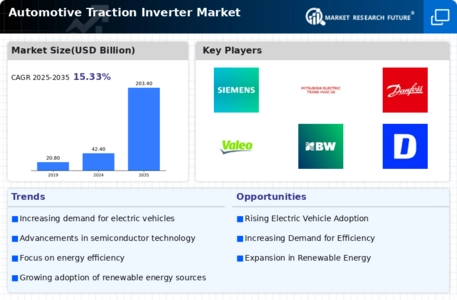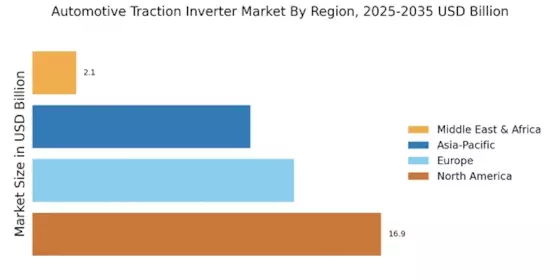Integration of Smart Features
The integration of smart features into automotive systems is becoming a pivotal driver for the Automotive Traction Inverter Market. As vehicles become more connected, the need for traction inverters that can communicate with other vehicle systems is increasing. Features such as real-time monitoring, predictive maintenance, and enhanced energy management are becoming standard in modern electric vehicles. This integration not only improves the overall efficiency of the vehicle but also enhances the driving experience. The market is seeing a rise in demand for inverters that can support these smart functionalities, which is likely to contribute to a robust growth trajectory. Analysts suggest that the incorporation of smart technologies could lead to a market expansion of approximately 10% over the next few years, underscoring the importance of innovation in the Automotive Traction Inverter Market.
Shift Towards Electrification
The Automotive Traction Inverter Market is experiencing a pronounced shift towards electrification, driven by increasing consumer demand for electric vehicles (EVs). This transition is largely influenced by stringent emissions regulations and the need for sustainable transportation solutions. As automakers pivot to electric powertrains, the demand for efficient traction inverters, which convert DC power from batteries to AC power for electric motors, is expected to surge. Recent data indicates that the EV market is projected to grow at a compound annual growth rate (CAGR) of over 20% in the coming years, further propelling the Automotive Traction Inverter Market. This shift not only enhances vehicle performance but also aligns with global sustainability goals, making traction inverters a critical component in the evolution of the automotive sector.
Government Incentives and Regulations
Government incentives and regulations are playing a crucial role in shaping the Automotive Traction Inverter Market. Many countries are implementing policies to promote electric vehicle adoption, including tax credits, rebates, and grants for EV manufacturers. These incentives not only lower the cost of electric vehicles for consumers but also encourage manufacturers to invest in advanced technologies, including high-performance traction inverters. Additionally, stringent emissions regulations are pushing automakers to develop cleaner technologies, further driving the demand for efficient traction inverters. Recent reports indicate that regions with robust government support for EVs are witnessing a significant increase in traction inverter sales, suggesting that regulatory frameworks are essential for the growth of the Automotive Traction Inverter Market.
Technological Advancements in Power Electronics
Technological advancements in power electronics are significantly influencing the Automotive Traction Inverter Market. Innovations such as silicon carbide (SiC) and gallium nitride (GaN) semiconductors are enhancing the efficiency and performance of traction inverters. These materials allow for higher switching frequencies and reduced energy losses, which are crucial for the performance of electric vehicles. The integration of advanced control algorithms and digital signal processing is also improving the responsiveness and reliability of traction inverters. As a result, the market is witnessing a shift towards more compact and lightweight inverter designs, which can lead to improved vehicle range and performance. The increasing adoption of these technologies is expected to drive the Automotive Traction Inverter Market, with projections indicating a potential market growth of over 15% annually in the next five years.
Rising Consumer Awareness and Demand for Sustainability
Rising consumer awareness regarding environmental issues is significantly impacting the Automotive Traction Inverter Market. As consumers become more conscious of their carbon footprint, there is a growing preference for electric vehicles over traditional internal combustion engine vehicles. This shift in consumer behavior is prompting automakers to enhance their electric vehicle offerings, which in turn increases the demand for efficient traction inverters. Market Research Future indicates that a substantial percentage of consumers are willing to pay a premium for sustainable vehicles, further driving the growth of the Automotive Traction Inverter Market. This trend suggests that as awareness continues to rise, the market for traction inverters will likely expand, reflecting a broader commitment to sustainability in the automotive sector.

















Leave a Comment